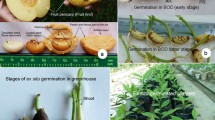Abstract
Vitellaria paradoxa or karité is a wild fruit-bearing tree species of sudano-sahelian parklands that plays an important socio-economic role in Sub-Saharan Africa due to the commercial and domestic value of the fruits. Principal constraints of karité fruit production are: long juvenile phase, slow growth, genetic variability and lack of knowledge regarding the cultivation of the species. To address these constraints and to enhance productivity and quality, five methods of grafting (side cleft, top cleft, tongue, chip budding and side veneer), two methods of pre-treatment of scions and rootstocks (washing with 10% sodium hypochlorite to wash off latex and sterilise and a control without washing), and two methods of protection of grafts against desiccation (covering with white plastic sheet and aluminium foil) were tested. The results showed decreasing success of survival of grafts 16 weeks after grafting for the five grafting techniques: side cleft (86.1%), tongue (80.9%), top cleft (78.1%), chip budding (38.1%) and side veneer (20.7%) grafting methods. The results also showed May to be the optimum time for grafting, with high rates of shoot growth and survival of grafts. The average annual growth rate of grafts was 12.6 cm. The pre-treatment of scions with 10% sodium hypochlorite, however, had no significant effect on survival of scions. There was also no significant difference in survival of scions between the two methods of protection of grafts against desiccation (aluminium foil and plastic sheet). Two grafts produced fruits two years after grafting using side veneer grafting.
Similar content being viewed by others
References
Andrews P.K. and Serrano Marquez C. 1993. Graft incompatibility.Horticultural Reviews 15: 183–232.
Bayala J., Teklehaimanot Z. and Ouedraogo S.J. 2002. Millet production under pruned tree crowns in a parkland system in Burkina Faso. Agroforestry Systems 54: 203–214.
Boffa J.M. 1995. Productivity and management of agroforestry parklands in the Sudan Zone of Burkina Faso,West Africa. Ph.D. thesis, Purdue University, West Lafyette, Indiana, 101 pp.
Boffa, J.M. 1999. Agroforestry parklands in sub-Saharan Africa. FAO conservation guide No 34, Rome, 230 pp.
Bonkoungou E.A. 1987. Monographie du karité Butyrospermun paradoxum (gaertn. F.) Hepper, espèce agroforestière à usages multiples. Institut de Recherches en Biologie et Ecologie Tropicale. Ouagadougou, Burkina Faso, 69 pp.
Boussim I.J., Sallé G. and Guinko S. 1993. Tapinanthus parasites du karité au Burkina Faso. 2ème partie: Phénologie, biologie et dégâts. Bois et Forêts des Tropiques 238: 53–65.
Chevalier A. 1946. L'arbre à beurre d'Afrique et l'avenir de sa culture. Oléagineux 1: 7–11.
Dembele F., Diakite B.M., Kone B. and Traore Y. 1987. Contribution de la mortalité du karité (Butyrospermum parkii G. Don Kotschy) dans les cercles de Ségou et Baraouéli. Mémoire de fin de cycle pour l'obtention de diplôme d'ingénieur des sciences appliquées: spécialité eaux et forêts de l'institut polytechnique rural de Katibougou (IPR), Mali, 65 pp.
de Saint Sauveur A. 2001. Indigenous management techniques of farmed parklands. In: Teklehaimanot, Z. (Ed.). Improved management of agroforestry parkland systems in Sub-Saharan Africa pp 84–92. EU/INCO Project Contract IC18-CT98-0261, Third Annual Progress Report, University of Wales Bangor, UK.
Grolleau A. 1989. Contribution à l'étude de la multiplication végétative par greffage du karité (Vitellaria paradoxa Gaertn.f.=Butyrospermum paradoxum Hepper). Bois et Forêts des Tropiques 222: 38–40.
Hackett W.P. 1985. Juvenility, maturation and rejuvenation in woody plants. Horticultural Reviews 7: 109–155.
Hall J.B., Aebischer D.P., Tomlinson H.F., Osei-Amaning E. and Hindle J.R. 1996. Vitellaria paradoxa. A Monograph. School of Agricultural and Forest Sciences, University of Wales Bangor, U.K., 105 pp.
Hartmann H.T., Kester D.E., Davies F.T. and Geneve, R.L. 1997. Plant Propagation: Principles and practices. Prentice Hall Inc., Upper Saddle River, New Jersey, 770 pp.
Kapoor M.L. 1981. A note on subsequent results of field grafting trails with Caribbean pine. Indian Forester 107: 60–62.
Kessler J.J. 1992. The influence of karité (Vitellaria paradoxa) and néré (Parkia biglobosa) trees on sorghum production in Burkina Faso. Agroforestry Systems 17: 97–118.
Leakey R.R.B., Wilson J. and Deans J.D. 1999. Domestication of trees for agroforestry in drylands. Ann. Arid Zone 38: 195–220.
Leakey R.R.B. 1985. The capacity for vegetative propagation in trees. In: Cannell MGR and Jackson JE (Eds.). Attributes of Trees as Crop Plants, pp. 110–133. Abbots Ripton: Institute of Terrestrial Ecology, UK.
Leakey R.R.B. and Newton A.C. (Eds.) 1994. Domestication of tropical trees for timber and non-timber products. MAB Digest 17, UNESCO, Paris, 97 pp.
Lovett P.N., Azad A.K., Paudyal K. and Haq N. 1996. Genetic diversity and development of propagation techniques for tropical fruit trees. In: Smartt J and Haq N. (Eds.). Domestication, Production and Utilisation of New Crops pp 286–287. ICUC, UK.
Lovett P.N. and Haq N. 2000. Evidence for anthropic domestication of the sheanut tree (Vitellaria paradoxa). Agroforestry Systems 48: 273–288.
Nikiema A., van der Maesen L.J.G. and Hall J.B. 2001. The impact of parkland management practices on plant resources diversity. In: Teklehaimanot, Z. (Ed.). Improved management of agroforestry parkland systems in Sub-Saharan Africa, pp. 57–66. EU/INCO Project Contract IC18-CT98-0261, Third Annual Progress Report, University of Wales Bangor, UK.
Ofori D.A. and Foli E.G. 1997. Grafting methods, seasonal effects on grafting and seed orchard management with reference to Cedrelle odorata. Ghana Journal of Forestry 5: 23–27.
Ruyssen B. 1957. Le karité au Soudan. L'Agronomie Tropicale 12 (2): 143–226.
Wiesman Z. and Maranz S. 2001. Chemical analysis of fruits of Vitellaria paradoxa. In: Teklehaimanot Z. (Ed.). Improved management of agroforestry parkland systems in sub-Saharan Africa, pp. 19–23. EU/INCO Project, Contract IC18-CT98-0261, Third Annual Progress Report, University of Wales Bangor, UK.
Wojtusik T., Felker P., Russell E.J. and Benge M.D. 1993. Cloning of erect, thornless, non-browsed nitrogen fixing trees of Haiti's principal fuelwood species (Prosopis juliflora). Agroforestry Systems 21: 293–300.
Author information
Authors and Affiliations
Rights and permissions
About this article
Cite this article
Sanou, H., Kambou, S., Teklehaimanot, Z. et al. Vegetative propagation of Vitellaria paradoxa by grafting. Agroforestry Systems 60, 93–99 (2004). https://doi.org/10.1023/B:AGFO.0000009408.03728.46
Issue Date:
DOI: https://doi.org/10.1023/B:AGFO.0000009408.03728.46




